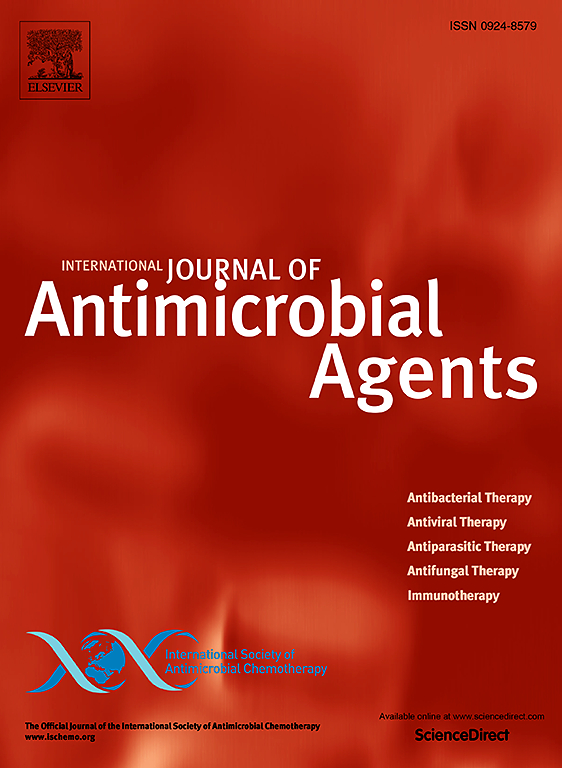The hidden threat: Klebsiella pneumoniae may develop co-resistance to colistin and cefiderocol under pressure of colistin
IF 4.9
2区 医学
Q1 INFECTIOUS DISEASES
International Journal of Antimicrobial Agents
Pub Date : 2025-01-17
DOI:10.1016/j.ijantimicag.2025.107445
引用次数: 0
Abstract
Objectives
Carbapenem-resistant Klebsiella pneumoniae (CRKP) has become a global concern owing to its difficult treatment. This study aimed to determine the impact of colistin resistance on susceptibility to cefiderocol.
Methods
The colistin-susceptible clinical strain CRKP12-130 (colistin minimum inhibitory concentration [MIC] 0.5 mg/L) was cultured in medium containing 4× and 8× the MIC of colistin. Eight colistin-resistant derivatives were randomly selected for susceptibility testing of cefiderocol and zeta potential changes. To compare the impact of colistin resistance on bacterial uptake of iron, growth curve experiments were conducted in cation-adjusted Mueller-Hinton broth (CAMHB) and iron-depleted CAMHB (ID-CAMHB). Resistant strains and the original strain CRKP12-130 were subjected to next-generation sequencing.
Results
Colistin MICs ranged from 16 to 128 mg/L for the eight colistin-resistant derivatives. The key genetic variants identified in colistin-resistant strains involved insertions and deletions in mgrB, and missense mutations in pmrB and phoQ. The colistin-resistant derivatives also exhibited reduced susceptibility to cefiderocol, with MICs increasing from 1 mg/L to 2–8 mg/L. Additionally, colistin-resistant strains demonstrated higher zeta potentials, ranging from -45.2 mV to levels between -32.8 mV and -14.2 mV. Resistant strains showed a more significant decrease in growth rate when cultivated in ID-CAMHB medium.
Conclusion
This study investigated the phenomenon of co-resistance to colistin and cefiderocol in CRKP under pressure of colistin. The simultaneous decrease in susceptibility poses a potential threat to the efficacy of clinical treatment of CRKP infections.
隐藏的威胁:肺炎克雷伯菌可能在粘菌素的压力下对粘菌素和头孢地罗产生共同耐药性。
目的:耐碳青霉烯肺炎克雷伯菌(CRKP)因其治疗困难已成为全球关注的问题。本研究旨在确定粘菌素耐药性对头孢地罗易感性的影响。方法:将粘菌素敏感临床菌株CRKP12-130(粘菌素最低抑制浓度[MIC] 0.5 mg/L)培养在4倍和8倍粘菌素MIC的培养基中。随机选取8个耐粘菌素衍生物对头孢地洛和zeta电位变化进行药敏试验。为了比较粘菌素耐药性对细菌铁摄取的影响,在阳离子调节的穆勒-辛顿肉汤(CAMHB)和缺铁的CAMHB (ID-CAMHB)中进行了生长曲线实验。对耐药菌株和原菌株CRKP12-130进行下一代测序。结果:8种粘菌素耐药衍生物的mic范围为16 ~ 128 mg/L。在粘菌素耐药菌株中发现的关键遗传变异包括mgrB的插入和缺失,以及pmrB和phoQ的错义突变。耐粘菌素衍生物对头孢地洛的敏感性也降低,mic从1 mg/L增加到2-8 mg/L。此外,耐粘菌素菌株表现出更高的zeta电位,范围从-45.2 mV到-32.8 mV至-14.2 mV。在ID-CAMHB培养基中培养时,抗性菌株的生长速率下降更为显著。结论:本研究考察了在粘菌素压力下CRKP对粘菌素和头孢地罗的共同耐药现象。同时易感性的降低对临床治疗CRKP感染的疗效构成了潜在的威胁。
本文章由计算机程序翻译,如有差异,请以英文原文为准。
求助全文
约1分钟内获得全文
求助全文
来源期刊
CiteScore
21.60
自引率
0.90%
发文量
176
审稿时长
36 days
期刊介绍:
The International Journal of Antimicrobial Agents is a peer-reviewed publication offering comprehensive and current reference information on the physical, pharmacological, in vitro, and clinical properties of individual antimicrobial agents, covering antiviral, antiparasitic, antibacterial, and antifungal agents. The journal not only communicates new trends and developments through authoritative review articles but also addresses the critical issue of antimicrobial resistance, both in hospital and community settings. Published content includes solicited reviews by leading experts and high-quality original research papers in the specified fields.

 求助内容:
求助内容: 应助结果提醒方式:
应助结果提醒方式:


